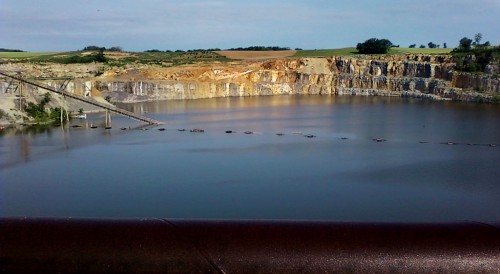 Whenever I’m in Cape, I hop on my bike and take a run down to South Sprigg to look over the edge of the cement plant quarry. I’ve always been fascinated by the place.
Whenever I’m in Cape, I hop on my bike and take a run down to South Sprigg to look over the edge of the cement plant quarry. I’ve always been fascinated by the place.
I saw a brief story in The Missourian in the past couple of weeks that the high water and flooding has caused the quarry to fill up. I kept waiting for a longer piece and now I can’t find the original one.
In the meantime, my mother’s neighbor across the street, Bill Bolton, sent me this photo showing that the water is way above the conveyor belt that carries the blasted material over Sprigg St. to the cement plant.
Last week there was a story in the paper saying that huge sinkholes have opened up and swallowed so many pieces of Sprigg Street that it’s closed “indefinitely.”
2002 Blowout
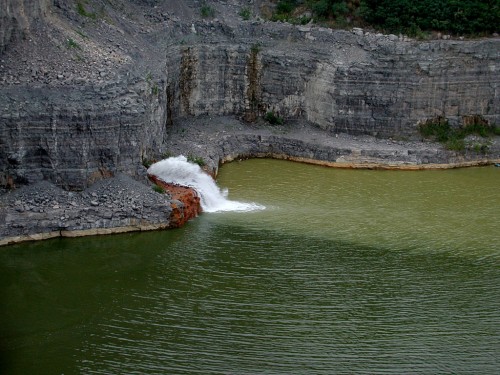 To put Bill’s photo in perspective, there was a huge blowout in July 2002 where a 25-foot-tall plume of water came blasting in. You can click on any photo to make it larger.
To put Bill’s photo in perspective, there was a huge blowout in July 2002 where a 25-foot-tall plume of water came blasting in. You can click on any photo to make it larger.
Conveyor area still dry
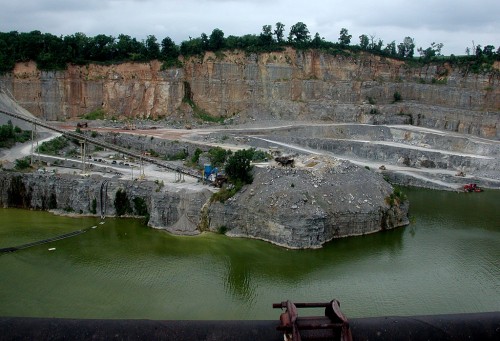 Even with that massive inflow of water, the conveyor area was still high and dry.
Even with that massive inflow of water, the conveyor area was still high and dry.
By fall 2002, flow was stopped
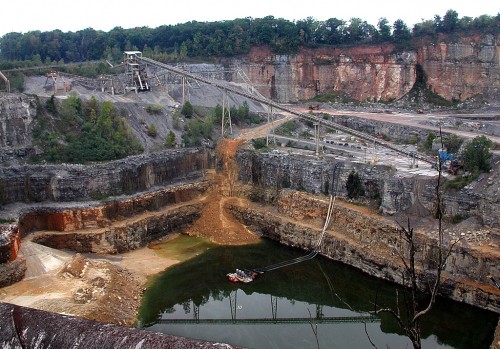 By my October 2002 visit, the flow had stopped and pumps had taken the water level down substantially.
By my October 2002 visit, the flow had stopped and pumps had taken the water level down substantially.
Nearly drained by October 2003
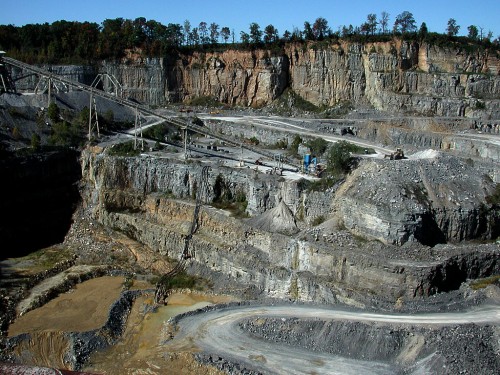 The water was almost completely gone by Oct. 15, 2003.
The water was almost completely gone by Oct. 15, 2003.
Fall 2010 aerial photo
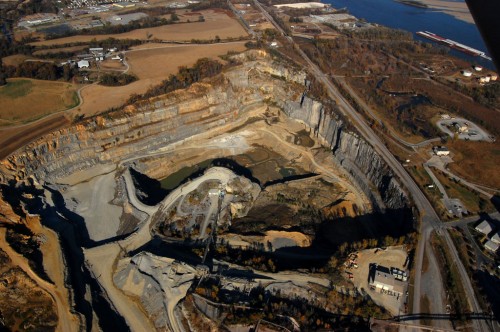 This is what the quarry looked like from the air on Nov. 6, 2010. The paved road on the right is S. Sprigg Street.
This is what the quarry looked like from the air on Nov. 6, 2010. The paved road on the right is S. Sprigg Street.
Seep water from Cape LaCroix Creek
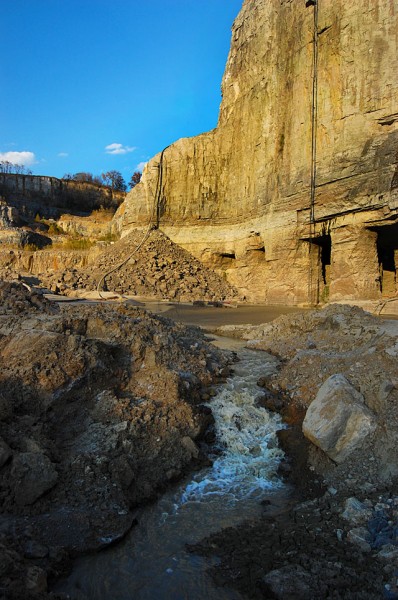 Nov. 10, 2010, I took a tour of the cement plant and was given my first trip to the bottom of the quarry since the mid-70s. I’ll run photos of that later, along with pictures of the massive caverns that were blasted out by the early miners.
Nov. 10, 2010, I took a tour of the cement plant and was given my first trip to the bottom of the quarry since the mid-70s. I’ll run photos of that later, along with pictures of the massive caverns that were blasted out by the early miners.
Buzzi Unicem Plant Manager Steve Leus said the water in the photo was coming in underground from Cape LaCroix Creek. Under normal circumstances, pumps can handle the flow.
The caves on the right are from some of the early mining. They extend under Sprigg Street. Steve said they’re not sure how far back they go.
Water rising April 2011
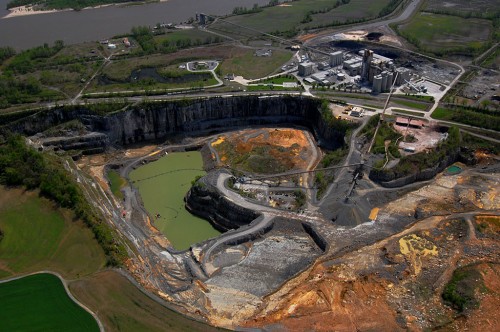 The river was just reaching flood stage at Cape when I took this photo on April 17, 2011. The lower portions of the quarry are beginning to hold water, but it’s a long way from where it was when Bill took his photo a few weeks later.
The river was just reaching flood stage at Cape when I took this photo on April 17, 2011. The lower portions of the quarry are beginning to hold water, but it’s a long way from where it was when Bill took his photo a few weeks later.
1966 aerial shows expansion
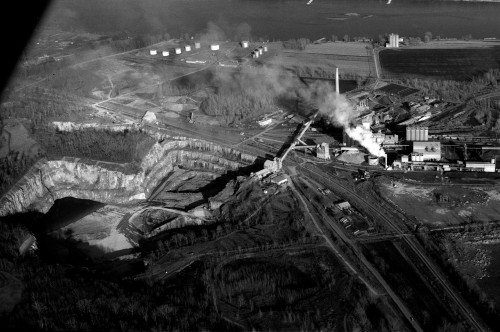 This aerial I shot of the cement plant and quarry shows just how much rock has been taken out in the last 45 years.
This aerial I shot of the cement plant and quarry shows just how much rock has been taken out in the last 45 years.

My father and other family members worked (and still do) at the cement plant. I remember my Dad telling me about rock hitting the office from a blast in the quarry. “Did you use too much dynamite there Butch?” The horn sounds and they close Sprigg street until after the blast. I wonder if they still do that? I would think technology would make it more predictable now.
I loved to go see my father at work and all the trucks, and train hauling rock to the plant. Quite a sight for a young boy. My Grandfather also worked there driving the train to haul rock around the plant. Many memories from that place. Thanks Ken for running this series.
My grandfather, Tom Yow, worked at this quarry. I’m not sure what years he was there. He also owned a small neighborhood grocery store in Cape around 1940-55. I grew up on South Sprigg. My brother, Mark, climbed up to the top of the cement plant building one day in pursuit of pigeons! He and his buddy, Skipper Kelley, decided to raise pigeons to sell. Unfortunately, there was also a tornado warning being issued at the same time. My mom was fit to be tied, because we didn’t know where Mark was. Needless to say, his butt got warmed up a bit when he did show up at home.
Anything that big and scary is going to be fascinating!
In 1997, I sent my engineering son up to Montana to check out Montana Tech to see if he wanted to go to graduate school there. The university was built on a “super site,” where an enormous quarry had filled up with water and become so toxic that geese would dissolve if they landed on it.
Thankfully, my son chose the University of Iowa for his graduate work. It was a much cleaner environment!
Thanks for this great article, Ken! My dad worked at the cement plant for twenty-five years before his death in 1965. It is amazing how much bigger that hole is now than when we lived in that area. I also remember the alarms sounding right before they blasted. I believe they still do.
WOW! As just about anyone who has peered over the ledge through the bushes along the road by the quarry, the sheer size of the hole is daunting, but seeing it this full of water is jaw-dropping.
I suspect that even Archimedes would take one look at this hole full of water and just shake his head and walk away.
I hope they have a lot of limestone piled up on the dry side, ’cause it’s going to take a long time to pump that back into the river and start harvesting more limestone…
How fascinating! I never saw into the quarry but always wanted to. The closest we ever got to it was the old Blue Hole BBQ stand on Sprigg Street.
Stick around. I’ve got pictures in the pipeline that will show you things that few folks who didn’t work there have ever seen.
I just have to decide if I’m going to do more research or if I’m going to put them up as photo galleries.
I’m headed out for a bike ride this afternoon and evening, so that makes photo galleries more likely.
A bunch of us teenage bikers got a good view of the Blue Hole late one night in the early 60s and I don’t mean the BBQ. We were riding down Sprigg St and the kid in the lead just turned and rode down into the quarry. Of course the rest of us followed. We rode all of the way down and started chasing each other around in the caves. When we came back up a guard came out of the shack and started yelling at us but we didn’t stop. I remember tall rooms with huge stone columns.
Unless I change my mind, the caves and columns are what I’m going to run tomorrow.
When we moved to Cape in 1962, the Blue Hole BBQ was one of the first places my dad took us to get BBQ. I remember thinking it was a lonely place for a BBQ stand. Is my memory flawed? When did it move to Kingshighway?
Here’s a piece I did about the Blue Hole.
It wasn’t so lonely in the old days. At one time, the cement plant employed at least 400 workers and Highway 61 crossed the Diversion channel not far south of there.
Sprigg Street was a major drag.
Ken, you are so good at what you do!! My father wored at the cement plant for over 40 years. He worked mostly in the packing house. It was a great treat to get to go down there with him and see things working. Thanks for the memories – again. Looking forward to the other pictures you have.
The cement plant has provided jobs to Cape locals for many years. But, in 1965 a job there brought the Durkins from the industrial side of Pittsburgh to the limestone bluffs of the Mississippi. Eldest son, Jack, was a memorable addition to the Class of 1967.
My husband Don worked as summer help at the cement plant after we were married in May of 1969. That was the summer Don learned that he had no future in jobs that required rotating shifts. He needs little sleep, but he need it at the same time each day (preferably at night.)
My dad worked in the lab as a chemist testing the cement product. I can still see the old building in my mind. I adored my Dad, and used to love it when he would take me to his work…..not often, but I do remember all the equipment and being so proud of him. He had been there for over 35 years when he was killed in an auto accident.
My husband’s grandfather work at the plant also. Worked on the trains. I think maybe drove some of them. They are now in the Arena and Capaha Parks.